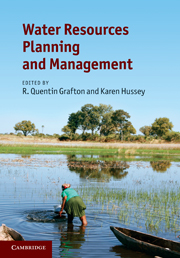Book contents
- Frontmatter
- Contents
- List of contributors
- Foreword
- Preface
- Acknowledgements
- Introduction
- Part I Understanding ‘water’
- Part II Water resources planning and management
- 8 Water law and the search for sustainability: a comparative analysis
- 9 Tackling the global water crisis: unlocking international law as fundamental to the peaceful management of the world's shared transboundary waters – introducing the H2O paradigm
- 10 Risk and uncertainty in water resources planning and management: a basic introduction
- 11 Collaboration and stakeholder engagement
- 12 Capacity building and knowledge sharing
- 13 Adaptive and integrated management of water resources
- 14 Gender and integrated water resource management
- 15 Environmental flows: achieving ecological outcomes in variable environments
- Part III Water resources planning and management: case studies
- Contributors
- Index
- References
12 - Capacity building and knowledge sharing
from Part II - Water resources planning and management
Published online by Cambridge University Press: 05 August 2011
- Frontmatter
- Contents
- List of contributors
- Foreword
- Preface
- Acknowledgements
- Introduction
- Part I Understanding ‘water’
- Part II Water resources planning and management
- 8 Water law and the search for sustainability: a comparative analysis
- 9 Tackling the global water crisis: unlocking international law as fundamental to the peaceful management of the world's shared transboundary waters – introducing the H2O paradigm
- 10 Risk and uncertainty in water resources planning and management: a basic introduction
- 11 Collaboration and stakeholder engagement
- 12 Capacity building and knowledge sharing
- 13 Adaptive and integrated management of water resources
- 14 Gender and integrated water resource management
- 15 Environmental flows: achieving ecological outcomes in variable environments
- Part III Water resources planning and management: case studies
- Contributors
- Index
- References
Summary
Introduction
The water sector has witnessed a substantial change in management focus since 1992 when both the Dublin Conference on Water and the Rio de Janeiro Summit on Sustainable Development adopted the four principles of integrated water resources management(IWRM) to guide governments towards better management of the resource (UN, 1993). Many subsequent international conferences have since reaffirmed the importance of IWRM as the new paradigm in water management. However, planning and implementation have been hampered by various factors, such as vested interests of the water sector and organisational constraints, of which the most important might be the lack of human and institutional capacities in water management organisations.
This chapter addresses the role of capacity building in the process of implementation of IWRM, and changing capacity building practices to meet the demands of a changing water management environment. To do that it gives a brief overview of capacity building in the water sector and its development to address changing capacity needs. Different approaches to capacity building are reviewed, and new trends in knowledge management and networking are discussed. The paper concludes with the question of how to measure outputs, results, and impacts of capacity building.
- Type
- Chapter
- Information
- Water Resources Planning and Management , pp. 274 - 291Publisher: Cambridge University PressPrint publication year: 2011
References
- 4
- Cited by

